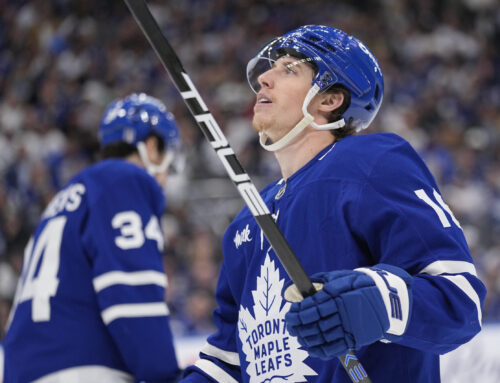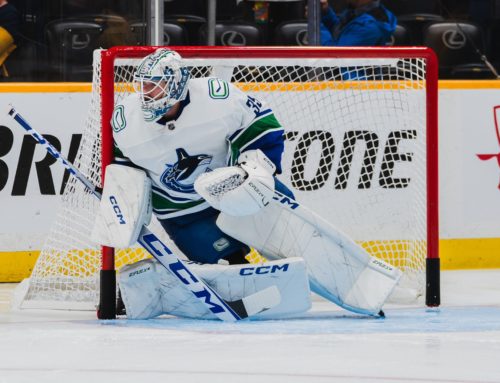Training camps don't start for a few weeks, but it's important to look ahead to start wrapping our collective heads around what to look for. My next few Ramblings are going to cover training camp battles, going division by division, and today we start with the Atlantic.
One thing I have noticed about team training camps over the last half-decade or so is that teams don't really waste time on them anymore. If, for example, teams have 50 players report to a training camp, probably 20 of them are irrelevant to us. It won't be long for those players to be separated into their second-tier camp while the main roster, plus some top prospects, are separated into the main camp. Subsequently, that also means it doesn't take long to get to pertinent line combinations, be they at even strength or on the power play.
The 2024-25 Dobber Hockey Fantasy Guide – available in the Shop here – goes through line combinations and does work on what power play units will be. I still want to take the time to go through some lineup positions I will be watching for once camps start. Here are the training camp battles I'm keeping an eye on.
Florida Panthers: Who is Running the Power Play?
Brandon Montour has moved on to the Seattle Kraken, and that opens up the top power play role in Florida. Over the last two seasons, Montour averaged 28 power play points every 82 games in that role, so it's prime real estate for fantasy production.
An important reminder here is that when Montour was removed from the top PP unit in the Stanley Cup Final, it was Oliver Ekman-Larsson, and not Aaron Ekblad or Gustav Forsling. It was not a handedness thing, either, as OEL is a left shot, but Montour is a right shot. Last season, Frozen Tools had Ekblad with nearly 27% of the available PP time and Forsling just over 10%, so Ekblad is the clubhouse leader.
However, as I wrote back in July, the signing of Adam Boqvist is an interesting one. He managed over 43% of Columbus's power play time in 2023-24, and was the go-to guy in 2022-23 when Zach Werenski was out for most of the season. He has a lot of experience running a power play and would have the most star-studded PP of his career in Florida. My guess is he at least gets a chance to carry that role, but we'll find out when camps start.
Toronto Maple Leafs: Auston Matthews, Mitch Marner, and…?
Every year, fantasy owners want to know who is going to skate on the top line next to Matthews and Marner. The simple answer is that this role can lead to 20-goal (Zach Hyman and Michael Bunting) or 60-point (Bunting) seasons, and if a player can bring good peripherals, it is more than enough production to be a good multi-cat fantasy option.
While Max Domi might make some sense for the top-line left wing spot, he's likely not good enough defensively to have the team rely on him for a full year with their top stars. It makes me wonder if this is the season that Matthew Knies gets moved to the top line. He had 15 goals and 20 assists last season, averaging over two hits per game, while skating under 14 minutes a night. If he can earn that top role, even without a prime power play spot, he has 20-goal, 50-point, 180-hit potential. Keep an eye on Leafs camp – not that it'll be hard to find that information – because Knies could be a breakout fantasy option this season.
Ottawa Senators: Even Power Play Units
Travis Green is the new head coach for the Ottawa Senators, so it remains to be seen how he'll run his squad. It is worth noting that in the six weeks he ran New Jersey's lineup towards the end of the 2023-24 season, Green almost exclusively used the same four forwards on the top PP unit, and they all got at least two-thirds, if not three-quarters, of the power play time. If he brings that approach to Ottawa, it'll be a big change because from January 1st onward, no Senators forward earned at least two-thirds of the team's power play time, and only Brady Tkachuk earned at least 60%. There is a big difference between Tim Stutzle earning 58% of his team's power play time and him earning 76%, and there is a big difference between Claude Giroux earning 53% of his team's power play time and earning 72%.
That difference applies to the defencemen, too. After January 1st, each of Jakob Chychrun, Thomas Chabot, and Jake Sanderson earned between 48%-54% of the team's power play time. Chychrun is now in Washington, but if the team goes to a heavily-used top unit, that will have a much bigger impact on the fantasy upsides of Sanderson and Chabot. Whichever guy can make the top unit return to form will get a massive boost in the fantasy game. We won't know which guy that is until training camp.
Buffalo Sabres: J.J. Peterka's Usage
With Jeff Skinner now in Edmonton, there is an open spot both in the Buffalo Sabres' top-6 and on their top power play unit. Assuming that the top PP unit has Tage Thompson, Alex Tuch, and Dylan Cozens, the fourth spot is up for grabs. It should go to Peterka, but options remain in Jack Quinn, Jordan Greenway, Jason Zucker, and Zach Benson. Not to mention that with Tuch, Quinn, Zucker, Benson, Greenway, and Peterka, there are six wingers – prospects notwithstanding – for four winger spots on the top two lines. I assume Peterka gets one of them, but some confirmation would be nice.
Back in 2022-23, we saw what a top line, top power play role can provide as Skinner surpassed 80 points. That is what awaits Peterka if he can get the right spot in the lineup. There is a new coach in Lindy Ruff, so it's ostensibly a clean slate, but there is a chasm of difference between top line/top PP usage and anything else.
Montreal Canadiens: What Does the Blue Line Look Like?
After the trade sending Jordan Harris to Columbus for Patrik Laine, things opened a bit on the Montreal blue line but there is still a lot of competition. On the right side, there is David Savard, Justin Barron, and Logan Mailloux likely for the roster with David Reinbacher likely headed to the AHL. The left side has Mike Matheson, Kaiden Guhle, Lane Hutson, Arber Xhekaj, and Jayden Struble. That makes eight, if not nine, defencemen for seven spots. All of Reinbacher, Mailloux, Hutson, Struble, and Guhle have contracts that can be sent to the AHL without waivers, and if we assume Reinbacher is sent down while Mailloux and Guhle are locks, it leaves Hutson and Struble.
I have maintained that I think Hutson goes to the AHL to start the year before a recall after 20-30 games, though the Harris trade has left me a little more uncertain. Also, Guhle has played the right side before so maybe Mailloux gets the short end of the stick. The long and short is that after Matheson, Guhle, and Savard, there is a lot of competition, and camps can create clarity.
Boston Bruins: Where Does Pavel Zacha Fit In?
Boston signed Elias Lindholm in the offseason, and he'll almost certainly be the top-line centre. They have Charlie Coyle returning and Matthew Poitras healthy. The Bruins signed Mark Kastelic who could take up fourth-line duties. It means that there isn't necessarily a need to leave Zacha at centre, and he could move to the left wing on one of the top two lines with Brad Marchand taking the other role. It could mean a top-6 that looks something like this:
Brad Marchand – Elias Lindholm – Morgan Geekie
Pavel Zacha – Charlie Coyle – David Pastrnak
There are ways things can look mighty different. Maybe the team wants to use Poitras on the wing rather than centre, or maybe they want to use Trent Frederic in the top-6 and leave Zacha as a centre. However, that top-6, plus Poitras and Frederic, makes eight forwards for six spots. With Lindholm, Marchand, and Pastrňák as locks, that leaves five forwards for three spots. How the team decides to use Zacha will tell us a lot about who will comprise the rest of the top two lines.
Detroit Red Wings: Who Skates with Dylan Larkin
Much like the Winnipeg Jets over the last several years, the Detroit Red Wings have had a difficult time finding a second-line centre to play behind their franchise centre. J.T. Compher has filled in well enough, but he seems more like a third-line centre on a contender rather than the second-line option. Regardless, whichever wingers get to the top line are in a much more advantageous fantasy position than those on the second line, so Larkin's line mates matter a lot.
Last season, Larkin's two most common line mates were Lucas Raymond and Alex DeBrincat. That is all well and good, but that leaves Vladimir Tarasenko and Patrick Kane as second-line wingers. Those guys are talented offensively, but porous defensively, and that combination would wind up spending a lot of time in the defensive zone. Can they really afford to leave Tarasenko/Kane together? Does Kane move up next to Larkin while Raymond moves down? Does Tarasenko move up and DeBrincat move down? There are options here, and two wingers are going to get a big downgrade in their centre.
Positions don't stay constant, but training camp should tell us how the team views the pecking order for skating on Larkin's flanks. That is vital fantasy information for us.
Tampa Bay Lightning: Can Brandon Hagel Earn a Meaningful Power Play Role?
Over the last two seasons, Hagel has posted 2.74 even strength points per 60 minutes. That is a top-25 mark in the league and higher than names like Mikko Rantanen, Roope Hintz, and Brady Tkachuk. Overall, his 113 even strength points are tied for 16th in the league, just five behind William Nylander and seven behind Jason Robertson. He has been an elite even strength performer, but his 20 power play points has crushed his fantasy upside. Nick Paul has been used instead of Hagel, and Tampa has had an elite power play, so it's hard to argue with the results.
Hagel has the potential to be over a point-per-game player with 20 PPPs and 200 shots on goal. He has shown tremendous offensive ability regardless of his line mates at even strength, but he needs those prime power play minutes to really ascend in the fantasy game. He is likely still on the outside looking in, but Tampa Bay's training camp should clarify this for us.





 MTL
MTL EDM
EDM
 ANA
ANA VAN
VAN OTT
OTT
